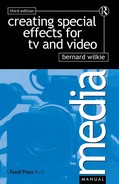Film Cameras
Although video cameras can now be made to record at varying speeds it is usual to employ film cameras for professional high and low speed requirements.
Many effects benefit from being slowed down or speeded up. For example, if a man falls from a roof top the action appears more effective if his fall occupies more time than it would at normal speed. This also applies to some explosions which become apparently more powerful when slowed down. Alternatively, some sequences benefit from being speeded up, such as the action of a gunslinger going for his Colt. Automobile crashes are nearly always enhanced by this technique when the action is in close up. In long-shot when they career over cliff-tops, they need to be slowed down of course.
Camera speeds
A high filming speed is used to slow down the action when projected. A slow filming speed is used to speed things up. There are, of course, limits to the speeds, both slow and fast, to which cameras can be run. Where very high speeds are required, special equipment must be obtained. Nevertheless most 16mm and 35mm cameras are capable of being run at speeds slower and faster than normal.
High speed cameras use a lot of film. Many dozens of feet pass through the gate as the camera motor gets up to speed and many more are wasted as it slows down again.
One problem encountered with high speed filming is the necessity to provide sufficient light. The faster the speed the more light is required and this often implies that the lights have to be positioned very close to the subject.
Stop-frame and time-lapse camera
Single-frame cameras used for cartoon and animation work are invariably custom-built for their particular purposes. Ordinary cameras designed for normal running may not hold each frame sufficiently steady to prevent the completed film from showing obvious signs of ‘hunting’.
Stop-frame cameras are usually operated remotely by solenoid and cable to avoid camera movement. Exposures with time-lapse cameras are invariably controlled by a time switch set to operate the shutter at pre-determined intervals. The timing device is also used to switch on the lights prior to a take and to switch them off afterwards. It is important to allow sufficient time for the lamps to warm up if the resultant film is to be flicker-free.
Explosions
Small explosions will look bigger if they are filmed at a slightly higher speed.

Falls
Dramatic sequences such as men falling from buildings can often benefit from prolonged motion. These call for the high speed camera.

Car chase
A car chase in which the driver must negotiate tricky or hazardous obstacles looks more impressive if the action is speeded up. This requires a slow speed camera.

Fights
Fight sequences are enhanced if the speed of action is increased. This calls for a slowed-down camera.

